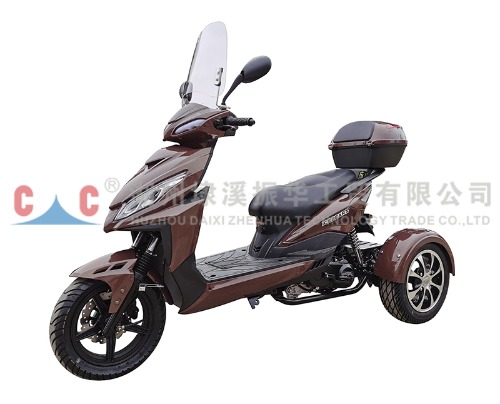In the vast spectrum of motorcycles, three-wheelers have always occupied a unique, almost eccentric space. However, when the conversation shifts from traditional cargo carriers or mobility scooters to a high-performance, futuristic-looking sports motorcycle, the perception is completely transformed. This particular model, often lauded as the “two-faced god” in its design philosophy, is gracefully shattering preconceived notions about what a motorcycle can be. Its aesthetic is a stunning ballet of contradictions, effortlessly marrying the aggressive, dynamic lines of a classic sports bike with the unparalleled stability and sci-fi allure of its three-wheeled structure. This design tension makes it look like a beast lying in wait when stationary, yet a swift, wind-cutting blade in motion, beckoning to every rider who craves a blend of individuality and adrenaline. More than just a vehicle, it’s a piece of art—a masterful fusion of mechanics, aesthetics, and practicality that perfectly embodies the harmony between performance and form.
The “two-faced god” moniker stems from the profound duality embedded in the very core of this sports three-wheeler’s design. It ingeniously integrates two seemingly opposing characteristics into a single, cohesive form. On one hand, its frontal design is aggressively styled with sharp lines, defined angles, and technologically advanced lighting systems that boldly declare its sporting DNA and untamed spirit. This design language is a clear statement of its speed and passion. On the other hand, its unique structure—whether with two wheels in the front or rear—provides an unparalleled sense of stability and security. This structural balance makes it visually substantial and instills a deep sense of trust in the rider. This clever fusion of the raw energy of a traditional motorcycle with the steadfastness of a three-wheeler allows it to offer both the thrill of speed and the unwavering confidence of a rock-solid ride. These two distinct traits coexist seamlessly in one vehicle, granting it the agility of a sports bike and the stability akin to a car, hence its fitting nickname.

The engine is the heart of any sports three-wheeler, and its displacement dictates the vehicle’s unique personality. Taking the common 400cc and 350cc options as examples, both are designed to deliver ample power, but they provide subtly different riding experiences. A 400cc engine typically boasts superior torque and higher horsepower output, enabling quicker acceleration from a standstill and a more effortless demeanor during high-speed cruising. It handles diverse road conditions with ease, whether overtaking or climbing hills, providing a sensation of unbridled power and pure riding exhilaration. In contrast, the 350cc engine offers a slightly more moderate power delivery, often with an advantage in smoothness and fuel economy. This makes it an ideal choice for riders who prioritize daily commuting or leisurely weekend trips, providing enough thrill without being overly aggressive. While each has its own focus, both engine sizes are built upon the foundation of delivering exhilarating power and stable handling, ensuring every journey is filled with joy and excitement.
Safety is a top priority for every rider, and three-wheeled motorcycles possess an inherent advantage in this regard. Compared to a traditional two-wheeled motorcycle, the three-wheel structure provides a fundamentally more solid foundation. During high-speed cornering, a two-wheeler requires the rider to lean into the turn to maintain balance, a maneuver that can be risky on slippery roads or in emergency situations. A three-wheeled motorcycle, especially those with a tilting dual-front-wheel design, can lean into corners like a two-wheeler, but its extra point of contact significantly enhances stability. Even on uneven surfaces or during sudden maneuvers, it effectively prevents skidding or tipping over. This structural innovation allows riders to revel in the thrill of speed with a heightened sense of security. It not only lowers the learning curve for novice riders but also offers a broader margin of control for experienced ones, proving that safety and passion are not mutually exclusive.
The true value of a sports three-wheeler extends far beyond its function as a mere mode of transport. It’s a symbol of a lifestyle, a pursuit of freedom and individuality. For the rider, it’s not just a tool for the daily commute but a trusted companion for weekend adventures. You can navigate bustling city streets or conquer winding mountain roads with equal confidence. Its unique riding experience blends the stability and comfort of a car with the exhilarating speed and unconstrained freedom of a motorcycle. The security it offers allows you to focus on the pure act of riding, feeling the road beneath you, and exploring the unknown. It’s a vehicle that liberates you from the monotony of daily life, providing a window to rediscover the world and yourself. This fulfillment on a spiritual level, transcending its physical function, is perhaps the most precious gift a sports three-wheeler can offer its rider.
In recent years, sports three-wheelers have captured a growing amount of attention on the global stage, signaling their immense potential for development. As consumers increasingly seek personalization, enhanced safety, and pure riding enjoyment, these vehicles perfectly fill the market gap between traditional two-wheeled motorcycles and four-wheeled cars. Looking ahead, it is reasonable to believe that with the continuous integration of new materials, electric propulsion, and smart connectivity technologies, sports three-wheelers will become even lighter, more environmentally friendly, and more intelligent. For instance, the introduction of electric versions will give them a distinct advantage in urban commuting, while the addition of smart rider-assist systems will further boost their safety and convenience. No longer a niche curiosity, this is a burgeoning category that is steadily moving towards the mainstream. It is safe to predict that in the future of transportation, the sports three-wheeler will play an increasingly vital role, becoming the ideal steed for many who seek a life of freedom and passion.